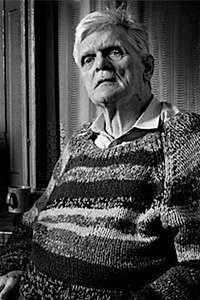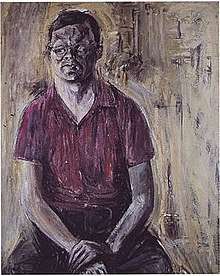John Heath-Stubbs
John Francis Alexander Heath-Stubbs OBE (9 July 1918 – 26 December 2006) was an English poet and translator. He is known for verse influenced by classical myths, and for a long Arthurian poem, Artorius (1972).

Biography and works
Heath-Stubbs was born in Streatham, London, although the family lived in Hampstead. His parents were Francis Heath-Stubbs and his wife, who was a concert pianist under the name Edie Marr. His boyhood was largely spent near the New Forest.[1]
Heath-Stubbs was educated at Bembridge School on the Isle of Wight and at the age of 21 went to Queen's College, Oxford, where he read English. There he found the lectures of Nevill Coghill and C. S. Lewis particularly rewarding. As poetry adviser to the firm of Routledge, he co-edited Eight Oxford Poets in 1941, with Sidney Keyes and Michael Meyer,[1] and helped to edit Oxford Poetry in 1942–1943.
By that time Heath-Stubbs had recognized his homosexuality. However, his love for the poet and artist Philip Rawson was returned only in the form of strong friendship. Heath-Stubbs returned in the early 1940s to regular Anglican worship.[1]
He held the Gregory Fellowship of Poetry at Leeds University in 1952–1955, and professorships in Alexandria, Egypt in 1955–1958 and at Ann Arbor, Michigan in 1960–1961. He taught at the College of St Mark and St John in Chelsea in 1962–1972, and at Merton College, Oxford for twenty years from 1972. He lived for a time in the 1950s at Zennor in Cornwall.
Heath-Stubbs's translations include works by Sappho, Horace, Catullus, Hafiz, Verlaine, and most notably Giacomo Leopardi. He was a representative figure in British poetry in the early 1950s, editing the poetry anthology Images of Tomorrow (1953), and with David Wright the Faber Book of Twentieth Century Verse, among others. He was elected to the RSL in 1954, awarded the Queen's Gold Medal for Poetry 1973, and appointed OBE in 1989.[2]

Although diagnosed with glaucoma at the age of 18, he was able to read with his left eye until 1961, but was completely blind from 1978.[1] Nonetheless he continued to write almost to the end. A documentary film about him, entitled Ibycus: A Poem by John Heath-Stubbs, was made by the Chilean director Carlos Klein in 1997.
John Heath-Stubbs died in London on 26 December 2006, aged 88.[2]
Writing style
As a Romantic poet, Heath-Stubbs's diction was strong, yet subtle. Running through his work was a nostalgia for "classicism". He was consciously literary and his work elaborately wrought rather than spontaneous, which meant his was not the kind of poetry likely to have mass appeal. However, his devotion to the craft of poetry makes his work impressive. As Edward Lucie-Smith put it, "Few writers of his time had a deeper knowledge of the English language, or cared for it more devotedly."[3]
Poetry collections
- 1942: Wounded Thammuz
- 1948: The Swarming of the Bees
- 1950: The Forsaken Garden: An Anthology of Poetry 1824–1909, edited with David Wright
- 1953: New Poems
- 1953: Faber Book of Twentieth Century Verse, edited with David Wright
- 1954: A Charm Against the Toothache
- 1962: The Blue-Fly in His Head
- 1965: Selected Poems
- 1969: Cosmic Poem
- 1972: Penguin Modern Poets 20, co editor
- 1974: Artorius: A Heroic Poem in Four Books and Eight Episodes
- 1978: The Watchman's Flute
- 1979: Omar Khayyám, The Rubaiyat, translated with Peter Avery
- 1981: In The Shadows - David Gray, editor
- 1982: Naming the Beasts
- 1985: The Immolation of Aleph
- 1987: Cat's Parnassus, Hearing Eye. ISBN 1-870841-00-X
- 1988: Collected Poems 1942–1987, Carcanet Press
- 1988: Time Pieces, Hearing Eye. ISBN 1-870841-02-6
- 1988: A Partridge in a Pear Tree: Poems for the Twelve Days of Christmas, Hearing Eye, illustrations by Emily Johns
- 1989: A Ninefold Of Charms, Hearing Eye, illustrations by Emily Johns
- 1990: Selected Poems
- 1992: The Parson's Cat, Hearing Eye, illustrations by Emily Johns
- 1993: Sweet-Apple Earth
- 1993: Hindsights : An Autobiography
- 1994: Chimaeras, Hearing Eye, lino etchings by Emily Johns
- 1996: Galileo's Salad
- 1998: The literary essays of John Heath-Stubbs, edited by A.T. Tolley
- 1999: The Sound of Light
- 2000: The Poems of Sulpicia, translator, Hearing Eye, illustrations by Emily Johns
- 2002: The Return of the Cranes
- 2005: Pigs Might Fly
References
- A. Curtis (2011): "Stubbs, John Francis Alexander Heath- (1918–2006), poet", Oxford Dictionary of National Biography (Oxford, UK: OUP). Retrieved 25 July 2019.
- Meyer, Michael (29 December 2006). "John Heath-Stubbs". Obituary from The Guardian. London, England. Retrieved 17 September 2018.
- Edward Lucie-Smith in British Poetry since 1945.
External links
- Interview from 1989
- Poet John Heath-Stubbs dies at 88, BBC News, 26 December 2006
- Obituary, The Independent, 27 December 2006
- Obituary, The Guardian, 29 December 2006
- National Portrait Gallery
- BBC Your Paintings in partnership with the PCF, portrait of John Heath-Stubbs by Peter Edwards
- Sebastian Barker - RSL
- Archival material at Leeds University Library
- "John Heath-Stubbs", Fellows Remembered, The Royal Society of Literature
- Stuart A. Rose Manuscript, Archives, and Rare Book Library, Emory University: John Heath-Stubbs collection, c. 1962–1967